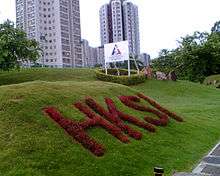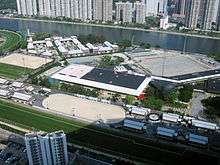Hong Kong Sports Institute
| 香港體育學院 | |
 | |
Former name |
Jubilee Sports Centre (1982-1991) |
|---|---|
| Chief Executive | Dr Trisha Leahy |
| Location | No. 25 Yuen Wo Road, Sha Tin, Hong Kong |
| Website |
hksi |
The Hong Kong Sports Institute (Chinese: 香港體育學院) is a sports institute in the Fo Tan, Sha Tin district of Hong Kong. It is mandated to provide training to athletes, and also offers academic qualification in the field of sports training.[1] The institute sponsors elite athletes and trains them as full-time employees, based on their talent and potential. The campus is located on reclaimed land on the bank of the Shing Mun River, next to the Sha Tin Racecourse.
History


The institute, then called the Jubilee Sports Centre (JSC), was envisioned to provide "top class coaching and training for promising and outstanding" athletes, with an emphasis on training young people and in providing a great variety of activities and programmes.[2] The Jubilee Sports Centre Ordinance was enacted in 1977.[3] Sir Alberto Rodrigues, chairman of the JSC Board, stated in 1977, "we do not see any sports excluded" and explained that the aim was to improve sports standards in the territory and that the centre would seek out skilled athletes to provide them further training.[2]
A 41-acre site beside the new Sha Tin Racecourse was chosen and construction was financed jointly by the Royal Hong Kong Jockey Club and the government, with additional support from the Queen's Silver Jubilee Fund. The thus-named Jubilee Sports Centre was opened by Prince Edward, Duke of Kent in 1982.[4] It was originally managed by the Jockey Club.
By 1986, the Jockey Club sought to make the Jubilee Sports Centre and Ocean Park independent entities, reportedly on the advice of the government to focus on racing activities following doping and fixing scandals and on the club's own policy to "leave the management responsibilities to an independent body once the club-financed projects can stand firm on their feet".[3] At the time, Ocean Park was making a profit of around $1 million per year, while the JSC was operating on a deficit. These operating costs were covered by the Jockey Club, Hong Kong's largest charity.[5] Financial control was transferred from the Jockey Club to the JSC board of directors, and the club paid the centre a $350 million grant designed to cover operating expenses up to 2007.[3][5] By 1991, it was reported that the centre was on track to exhaust these funds "well before" 2007.[6]
In 1989, the Executive Council recommended the establishment of the Hong Kong Sports Development Board to bolster athletic training in the territory, and "envisaged that, in support of such objectives, the Jubilee Sports Centre should be developed into a Hong Kong Sports Institute".[7] Secretary for Home Affairs Peter Tsao moved a name change bill in the Legislative Council in February 1991 to "reflect more accurately its role in promoting sport".[8] The centre was renamed "Hong Kong Sports Institute" later that year.[4]
The institute was the site of equestrian events of the 2008 Summer Olympics. In order to make way for the Olympic Games, the sports institute temporarily relocated to the YMCA Wu Kwai Sha Youth Village in January 2007 and the Hong Kong Jockey Club took over the site to prepare it for competition.[9]
Recent expansion
In the 2006-2007 edition of the policy address, the Chief Executive announced a major redevelopment of the HKSI "to provide world-class training facilities to elite athletes in Hong Kong".[10] The government allocated $1.8 billion for this redevelopment in 2008.[11] Many new facilities have been constructed in the years since, and existing venues were refurbished.
The outdoor velodrome beside the Fo Tan Nullah was dismantled. In its place a nine storey Main Building was erected to house offices, hostels for local and visiting athletes, a canteen, conference and lecture rooms, a 400-seat auditorium, and related ancillary facilities.[10] The Main Building opened in 2013.[12] To replace the cycle track, a temporary velodrome was built at Whitehead, Wu Kai Sha, to serve athletes until the indoor Hong Kong Velodrome opened in Tseung Kwan O New Town in 2014.
The existing 25-metre swimming pool was joined by a new Olympic-size swimming pool, with the two venues integrated into a single indoor complex. At the north end of the campus a new multi-purpose sports centre was built, housing a new tenpin bowling alley, squash courts, and a martial arts training centre. The architect for the redevelopment of the HKSI was P&T Architects and Engineers.[13]
Facilities
- running/cycling track
- football/rugby pitch
- 120-metre covered warm-up track
- international size indoor swimming pool
- 25-metre indoor swimming pool
- squash courts
- 12-lane bowling centre
- martial arts training venue
- boccia venues
- badminton hall
- tennis courts
- table tennis hall
- rowing centre
- fencing area
- sport science laboratories
- sport medicine clinics
- fitness training centre
Transportation
The institute is linked to Fo Tan Station on the East Rail Line via a footbridge spanning the Tai Po Road. It is also accessible via the extensive cycle track network serving Sha Tin.
References
- ↑ "B. Ed. Programme in Sports Training". Sports Coaching. Hong Kong Sports Institute. Retrieved 22 June 2014.
- 1 2 "Jockey Club gives sports complex a $-for-$ boost" (PDF). Hong Kong Standard. 24 June 1977. Retrieved 18 November 2014.
- 1 2 3 Li, Wing-on (23 July 1986). "$350 bill to rid Club of sports centre responsibility" (PDF). Hong Kong Standard. Retrieved 18 November 2014.
- 1 2 "The Jubilee Sports Centre, c. 1980s". The Hong Kong Jockey Club Archives. Hong Kong Memory. Retrieved 17 April 2014.
- 1 2 "Top club may leave ventures" (PDF). South China Morning Post. 7 June 1986. Retrieved 18 November 2014.
- ↑ Walker, Jeremy (17 May 1991). "Jeremy Walker examines the Hongkong Sports Development Board's new four-year plan which hopes to push the territory into a new sporting league" (PDF). South China Morning Post. Retrieved 18 November 2014.
- ↑ "Jubilee Sports Centre (Amendment) Bill 1991" (PDF). Hansard. Legislative Council. 27 February 1991. Retrieved 18 November 2014.
- ↑ "Polytechnics face staff shortage" (PDF). South China Morning Post. 28 February 1991. Retrieved 18 November 2014.
- ↑ "LC Paper No. CB(2)1493/06-07(02) (Revised):" (PDF). Legislative Council Panel on Home Affairs Redevelopment of the Hong Kong Sports Institute. Legislative Council of Hong Kong. 13 April 2007. Retrieved 18 November 2014.
- 1 2 "LC Paper No. CB(2)1980/09-10(06): Background brief prepared by the Legislative Council Secretariat for the meeting on 9 July 2010, Redevelopment of Hong Kong Sports Institute" (PDF). Panel on Home Affairs. Legislative Council of Hong Kong. Retrieved 18 November 2014.
- ↑ "Speech by CE at HKSI Main Building opening ceremony". Hong Kong Government. 25 October 2013. Retrieved 18 November 2014.
- ↑ "Facilities Brochure" (PDF). Hong Kong Sports Institute. Retrieved 18 November 2014.
- ↑ "Redevelopment of Hong Kong Sports Institute" (PDF). HKIA Journal Issue No. 55. Hong Kong Institute of Architects. 3 November 2009. pp. 56–59.
External links
| Wikimedia Commons has media related to Hong Kong Sports Institute. |
Coordinates: 22°23′41.88″N 114°12′07.44″E / 22.3949667°N 114.2020667°E
